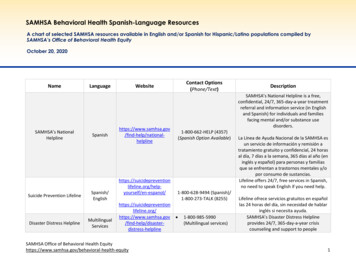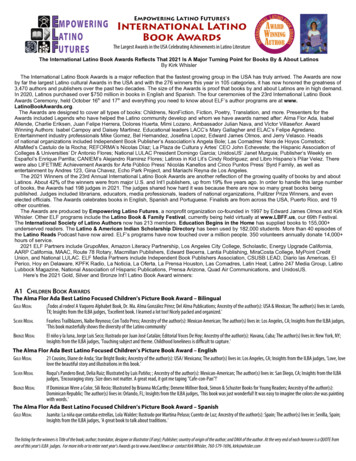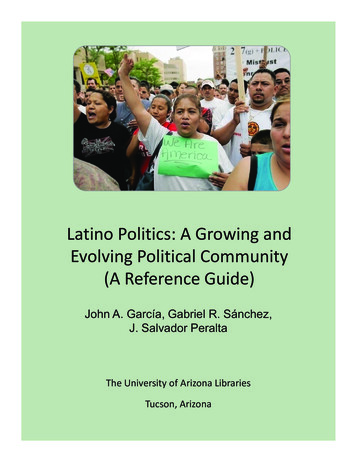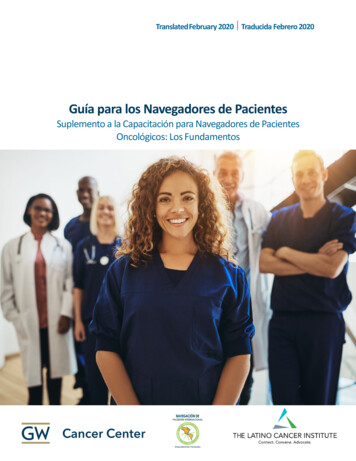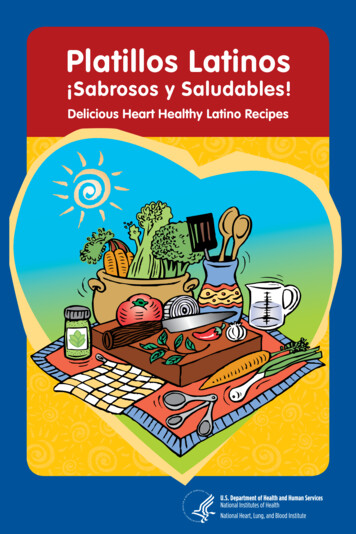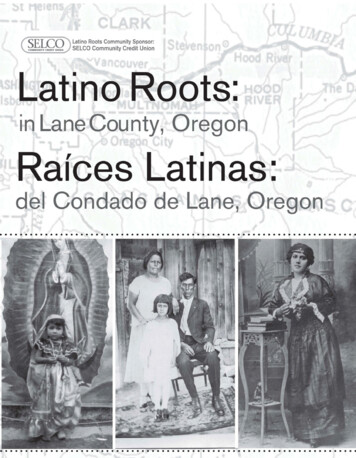
Transcription
The Center for Latino/a and Latin American Studies (CLLAS)The Center for Latino/a and Latin American Studies (CLLAS) at the Universityof Oregon provides an interdisciplinary intellectual space for putting Latino, Latina,and Latin American studies in conversation with one another. The primary purpose ofCLLAS is to facilitate collaborative research, scholarship, intellectual community, andcommunity outreach focused on Latin America and U.S. Latino and Latina populations.El Centro de Estudios Latinos/as y Latinoamericanos (CLLAS) de la Universidad deOregón proporciona un espacio interdisciplinario que ponga los estudios latinos ylatinoamericanos en conversación mutua. El propósito primario de CLLAS es facilitaruna comunidad intelectual, la investigación colaborativa, y difusión en comunidadeslatinoamericanas y de latinos en los Estados Unidos.For more information about CLLAS or to order copies of this report contact:Para obtener más información sobre CLLAS o para pedir copias de este informecomuníquese:Center for Latino/a and Latin American Studies (CLLAS)337 Hendricks Hall6201 University of OregonEugene OR 97403-6201Phone: (541) 346-5714E-mail: cllas@uoregon.eduCover Images from Left to Right: Patricia Córtez, celebration of Virgin of Guadalupe, c. 1966.Rose Mary Villanueva’s mother with her parents, c. 1935; Jose Luis Sámano’s grandmother in the 1930s.Imágenes de la Portada de izquierda a derecha:Patricia Córtez, Celebración de la Virgen de Guadalupe, c. 1966.La madre de Rose Mary Villanueva con sus padres c. 1935; La abuela de José Luis Sámano en la década de 1930.
AcknowledgementsLatino Roots Project Coordinator: Lynn StephenLatino Roots Research Team: Lynn Stephen (Departments of Anthropology and Ethnic Studies, CLLAS, UO), Gabriela Martínez (School of Journalism and Communication, UO), Mauricio Magaña, and Lukacs Nguyen (Department of Anthropology,UO), Sonia De La Cruz (School of Journalism and Communication, UO), Guadalupe Quinn (Amigos Multicultural Services).Exhibit and Text Translators: Magali Morales and José Juan TorresSpecial thanks to Robert Hart, Director of the Lane County Historical Society and Museum and Mary Dole, curator of the“Changing Demographics: The People of Lane County” exhibit which was up from January 2009 through March 2010at the Lane County Historical Museum in Eugene, Oregon. We appreciate their support of this project. They are responsiblefor the larger catalogue that this publication is excerpted from and we appreciate their permission to publish the material here.Designer: Megan Blankenship.This project was supported by the Center for Latino/a and Latin American Studies (cllas.uoregon.edu) with the Center for theStudy of Women in Society (csws.uoregon.edu). In addition to this booklet, the Latino Roots project involves classes at theUniversity of Oregon, two video documentaries, and a website and digital archive. The Latino Roots project is administeredthrough the Center for Latino/a and Latin American Studies (CLLAS) and is a part of the “Americas in a Globalized World:Linking Diversity and Internationalization” big idea at the University of Oregon.For further information on the project please write to cllas@uoregon.eduAgradecimientosCoordinadora del proyecto Raíces Latinas: Lynn StephenEquipo de Investigación de Raíces Latinas: Lynn Stephen (Departments of Anthropology and Ethnic Studies, CLLAS, UO),Gabriela Martínez (School of Journalism and Communication, UO), Mauricio Magaña, and Lukacs Nguyen (Department ofAnthropology, UO), Sonia De La Cruz (School of Journalism and Communication, UO), Guadalupe Quinn (Amigos MulticulturalServices).Traductores de la Exhibición y Los Textos: Magali Morales and José Juan TorresNuestro agradecimiento especial para Robert Hart, Director del Museo y Sociedad Histórico del Condado de Lane y MaryDole, Curadora de la exhibición, “Demografías Cambiantes: La Gente del Condado de Lane,” que se exhibió de enero del2009 a marzo del 2010 en el Museo Histórico del Condado de Lane en Eugene, Oregon. Apreciamos su apoyo al proyecto deRaíces Latinas. Ellos son responsables del catálogo de la exhibición donde aparecieron primero los textos y las fotos que aquípresentamos. Queremos agradecerles su permiso para publicar este material. Diseñadora: Megan Blankenship.El proyecto “Raíces Latinas” recibió apoyo del Centro de Estudios Latinos/as y Latinoamericanos (cllas.uoregon.edu) y elCentro de Estudios de la Mujer en la Sociedad (csws.uoregon.edu). Además de esta publicación, el proyecto de Raíces Latinas incluye cursos en la Universidad de Oregon, dos videos documentales, y un sitio de internet y archivo digital. El proyectode Raíces Latinas se administra através del Centro de Estudios Latinos/as y Latinoamericanos (CLLAS) y forma parte de lainiciativa en la Universidad de Oregon titulada “Las Américas en un Mundo Globalizado: Vinculando Diversidad e Internacionalización.Para mas información sobre el proyecto se puede escribir a “cllas @uoregon.edu.”
José Luis Sámano’s grandmother in the 1930’s. La abuela de Sámano.LATINO ROOTSSTORIESHistorias de las Raíces Latinas1
Latino Roots Timeline1513: The Spanish explorer Balboa Vasquéz de Nuñezsolidifies Spain’s claim to the west coast of NorthAmerica by claiming the Pacific Ocean and all of thelands it touches.1700s: Spanish adventurers such as Juan Pérez (1774),move beyond exploration and settlement in Californiaand begin to explore the Northwest Coast, includingwhat is now Oregon.1819: The Transcontinental Treaty is established in whichthe United States assumes all Spanish claims north ofthe 42nd parallel (now marking the California/OregonBorder).1819-1846: Oregon Country borders with Mexico andBritish Canada.1821: Mexico becomes independent of Spain in 1821;the Oregon Country southern border becomes the U.S.territorial border with Mexico.1848: The U.S. and Mexico sign the Treaty of GuadalupeHidalgo which calls for Mexico to give up more thanhalf of its territory. This includes the current statesof California, Arizona, New Mexico, Texas and parts ofColorado, Nevada, and Utah for which the U.S. pays 15 million in compensation for war-related damage toMexican land. The Oregon Territory (which still includesthe present-day states of Washington and Idaho) goesfrom being the U.S. border territory with Mexico tosharing a border with the soon to be state of California(given statehood in 1850).1850s: Mexican mule packers supply the Second RegimentOregon Mounted Volunteers during the Rogue River Warwho fight against Oregon’s native peoples defending theirterritory.1869: Mexican vaqueros bring large herds of cattle drivenup from California to eastern Oregon.1910: By this year Oregon ranks seventh among statesoutside the Southwest with Mexican-born residents whocome to work in farm production and on railroads.1910-1925: Mexican workers are contracted to work insugar beets and on railroads in Portland, eastern Oregonand in other parts of the state. The first Mexican familiessettle permanently in the state.1942-1947: More than 15,000 bracero workers cometo the state to work in agriculture. Additional workersare employed on railroads. Lane County hosts braceroworkers.21950s: Mexican and Mexican-American families settle inseveral areas of the state.1967: High School Equivalency Program (HEP) establishedat University of Oregon. HEP is a federally fundedprogram providing assistance to individuals from migrantand/or seasonal farm worker backgrounds to obtain theirhigh school degree.1969: Committee on Ethnic Studies formed at Universityof Oregon, including Latino participation. Ethnic Studiesbecomes a program in 1972. The same year EthnicStudies is established at LCC.1970s: University of Oregon branch of MovimientoEstudiantil Chicano de Atzlán (MEChA) established. ElSombrero, restaurant owned by Victoria and WalterWallace was in operation.1971: The Commission for Chicano Affairs is established.In 1983, the group is renamed the Governor’s Commissionon Hispanic Affairs.1978: Chicano Affairs is established in Eugene to dealwith local issues for Chicanos, Mexican-Americans, andother Latinos.Late 1970s: La Tiendita, now known as Taco Locofounded by Oscar Hernández on Blair St.1981: First Spanish Mass at St. Thomas More NewmanCatholic Center, University of Oregon.1986: San Pablo Mission is established to aid families inthe process of legalization through 1986 IRCA law.1991: First Fiesta Latina.1996: Susan Castillo becomes first Latina woman in theOregon State Senate.1996: CAUSA forms in Oregon with Lane County officeestablished. CAUSA is Oregon’s statewide, grassrootsimmigrant rights coalition. CAUSA works to defend andadvance immigrant rights through coordination withlocal, state, and national coalitions and allies.2002: Susan Castillo elected as State Superintendent ofSchools.2004: Charles Martínez elected to Eugene School Board.In 2007 he becomes chair of the 4-J School Board.2004: Cesar Chavez Elementary School created inEugene, Oregon.
Cronología de las Raíces Latinas1513: El explorador español Balboa Vásquez de Núñezsolidificó el dominio español de la costa oeste deNorteamérica al proclamar sus derechos sobre el OcéanoPacífico y todas las tierras aledañas a él.1700-1800: Los aventureros españoles como Juan Pérez(1774) pasaron de la exploración y asentamientos enCalifornia, a explorar la costa del noroeste, incluyendo elterritorio que hoy conocemos como Oregón.1819: Se establece el Tratado Transcontinental, en elque los Estados Unidos se apropian de todos los dominiosespañoles al norte del paralelo 42 (que hoy demarca lafrontera entre Oregón y California).1819-1846: El Territorio de Oregón comparte fronteras conMéxico y Canadá Británica.1821: Mexico se independiza de España, la frontera surdel Territorio Oregonense se convierte en la fronterapolítica entre los Estados Unidos y México.1848: México y los Estados Unidos firman el Tratado deGuadalupe Hidalgo, el cual cede más de la mitad delterritorio mexicano a los EEUU. Éste incluye los actualesestados de California, Arizona, Nuevo México, Texas, ypartes de Colorado, Nevada y Utah, por los cuales losEEUU pagaron 15 millones en compensación por el dañoocasionado por la guerra a las tierras mexicanas. ElTerritorio de Oregón (que todavía incluía los actualesestados de Washington e Idaho) pasó de constituir lafrontera de los Estados Unidos con México, a compartiruna frontera con el que pronto se constituiría como elestado de California (investido como tal en 1850).1850s: Mexicanos dedicados al transporte de carga enmulas proveen al Segundo Regimiento Oregoniano deVoluntarios Montados durante la Guerra del Río Rogue, enque lucharon contra los indígenas oregonés que defendíansu territorio.1869: Arrieros mexicanos conducen grandes manadas deganado vacuno de California al este de Oregón.1910: Para este año, Oregón ocupaba el séptimo lugarentre los estados fuera del Sureste Estadounidense en quelos residentes de origen mexicano venían a trabajar en losferrocarriles y la producción agrícola.1910-1925: Se contrata a trabajadores mexicanos en laproducción de la remolacha azucarera y los ferrocarrilesde Portland, el este de Oregón, y otras partes delestado. Las primeras familias mexicanas se asientanpermanentemente en el estado.1942-1947: Más de 15,000 trabajadores participantes enel Programa Bracero acuden al estado a realizar laboresagrícolas. Trabajadores adicionales se emplean en eldesarrollo de los ferrocarriles. Lane County recibe atrabajadores braceros.1950s: Familias mexicanas y mexicanas americanas seasientan en varias zonas del estado.1967: Se establece el programa HEP de Equivalencia dela Educación Media Superior (High School EquivalencyProgram) en la Universidad de Oregón. El HEP es unprograma que recibe fondos federales y brinda asistenciaa individuos de familias migrantes o de trabajadoresagrícolas temporales para la obtención de su certificadode bachillerato.1969: Se forma el Comité de Estudios Étnicos en laUniversidad de Oregón con participación latina. ElPrograma de Estudios Étnicos se consolida en 1972. Elmismo año se establece un programa de Estudios Étnicosen Lane Community College (LCC).1970s: Se establece una sucursal del MovimientoEstudiantil Chicano de Aztlán (MEChA) en la Universidadde Oregón. Se establece El Sombrero, restaurantepropiedad de Victoria y Walter Wallace.1971: Se crea la Comisión para Asuntos Chicanos. En 1983es rebautizada como la Comisión de Asuntos Hispanos delGobernador del Estado.1978: Se establece una oficina de Asuntos Chicanos enla Ciudad de Eugene para tratar con temas locales enrelación a los chicanos, mexicano-americanos y otroslatinos.Fines de los 1970s: La Tiendita, hoy conocida como TacoLoco es fundada por Óscar Hernández en el BoulevardBlair.1981: Se realiza la primer misa en español en el CentroCatólico St. Thomas More Newman de la Universidad deOregón.1986: Se establece la Misión San Pablo con el propósito debrindar asistencia a las familias en proceso de legalizar suresidencia mediante la ley de la reforma migratoria (IRCA)de 1986.1991: Se celebra la primer Fiesta Latina.1996: Susan Castillo se convierte en la primer mujer latinamiembro del Senado del Estado de Oregón.1996: Fundación de CAUSA en Oregón con oficina en elCondado de Lane. CAUSA es la coalición estatal porlos derechos de los inmigrantes, con membresía debase. CAUSA tiene la misión de defender y promoverlos derechos de los inmigrantes en coordinación concoaliciones y aliados a nivel local, estatal y federal.2002: Susan Castillo es electa como SuperintendenteEstatal de las Escuelas.2004: Charles Martínez es electo miembro del ConsejoEscolar de Eugene. En 2007 se convierte en presidentedel Consejo Escolar 4-J.2004: Se funda la escuela primaria César Chavez enEugene, Oregón.3
Shifting Racial and Ethnic Categories inthe U.S. Census Through TimeFrom 1930 until 1980 a key question has been how todocument the presence of people of Mexican, LatinAmerican, and Caribbean descent if they were primarilyrecorded as “white.” The category “Mexican,” in 1930,was used to allow census enumerators to describe Mexicanlaborers. After that, Mexicans were often classified as“white.” From 1940 until 1980, cultural criteria were usedin the census. The 1940 census used the definition “personsof Spanish mother tongue.” In the 1950 and 1960 censuses,“persons of Spanish surname” were reported. In the 1970census the definition of the categories changed again andindividuals chose between several Hispanic origins such as“Mexican” or “Puerto Rican.”In 1980, the category of “Hispanic” appears on the censusfor the first time and respondents are asked to indicate theirrace and whether or not they are of Hispanic or Spanishorigin. The term Hispanic included four subcategories:Mexican, Mexican American or Chicano; Puerto Rican; Cuban;Other Spanish/Hispanic. The 1980 and 1990 census forms used the four-color scheme in the race question,but the specifics varied. In 1980 and 1990, people were requested to “fill in one” racial category. This wasfollowed by the question “Is this person of Spanish/Hispanic Origin?” and then national identity designations,“Mexican/Mexican American/Chicano, Puerto Rican, Cuban, and “Other Spanish/Hispanic.” In the 1980 censusany person selecting “Other” was asked to specify by writing in the particular group. In 1990, specific groupswere listed to choose from. According to Rodriguez, more than 40 percent of Hispanics chose the “other race”category in the 1980 and 1990 censuses and wrote in the name of their ‘home’ Latino country or group.Rose Mary Villanueva with her students in Springfield,Oregon. Rose Mary Villanueva con sus estudiantes enSpringfield, Oregon.The term “Latino” was added to “Spanish/Hispanic” and put first in the 2000 census. It then went on to askthe individual’s race listing 15 options, along with “some other race” allowing individuals to mark one or moreraces. The 2000 census was the first time that indigenous Latin American and indigenous Mexican immigrantscould make their presence known through two distinct census categories. For the first time self-identifiedLatin American indigenous migrants could identify both ethnically as Latinos and racially as American Indians.Oregon reported 5,081 Hispanic American Indians in the 2000 census, but estimates from the Mexican consulatein Portland have put the numbers of indigenous Mexican immigrants in Oregon as high as 100,000 when bothtemporary and permanent residents are counted. The Associated Press, 2006, stated that officials estimate thatthere are at least 100,000 Mixtec speakers in the United States from Oaxaca alone, most of them in Oregon andCalifornia’s Central Valley.Sources:- Associated Press. 2006. More Mexican Migrants Speak No Spanish. September 18, 2006. Available at 9/18/123100.shtml- RodrÍguez, Clara E. 2000. Changing Race: Latinos, the Census, and the History of Ethnicity in the United States. NewYork: New York University Press.- Stephen, Lynn M. 2007. Transborder Lives: Indigenous Oaxacans in Mexico, California, and Oregon. Durham: DukeUniversity Press.- U.S. Census Bureau: State and County QuickFacts. Last Revised: Tuesday, 18-Sep-2012Latinos in Lane County by the NumbersCensus CategoryLatino Population1940195019601970Nonwhite ForeignMexicanSpanishBorn Other Born; Puerto LanguageRican77244118;112,66269,019Total PopulationLatinos as Percent .1%of Population419801990Hispanic HispanicOrigin2000Hispanicor Latino2010Hispanicor %2.4%4.6%351,7157.6%
Las Categorias Raciales y Étnicas Cambiantes enLos Censos Estadounidenses a lo Largo del TiempoDe 1930 a 1980 una interrogante importante ha sido cómo documentar la presencia de personas de origenmexicano, latinoamericano y caribeño si éstos eran registrados principalmente como “blancos.” Lacategoría “mexicano,” en 1930, era utilizada por los funcionarios censales para describir a los trabajadoresmexicanos. Después de ese censo, los mexicanos fueron clasificados a menudo como “blancos.” De 1940a 1980 se utilizaron criterios culturales en el censo. El censo de 1940 utilizaba la descripción “personascuya lengua madre es el español.” En los censos de 1950 y 1960 se reportaron las “personas de apellidoespañol”. En el censo de 1970 la definición de las categorías cambió una vez más y los individuos debíanelegir clasificarse en varias categorías de “origen hispano” como “mexicanos” o “puertorriqueños.”En 1980 apareció por primera vez la categoría de “hispano” y se le pidió a los encuestados que indicaran suraza y respondieran si eran de origen hispano o español o no. El término “hispano” incluía 4 subcategorías:mexicano, mexicano americano o chicano; puertorriqueño; cubano; y “otro origen español/hispano.” En1980 y 1990, se le pidió a las personas que eligieran sólo una categoría racial. A esto le seguía la pregunta“¿Es esta persona de origen español/hispano?”, y las designaciones de origen nacional, incluyendo“mexicano/mexicano americano/chicano, puertorriqueño, cubano, y ‘otro origen español/hispano.’” Enel censo de 1980 se le pedía a toda persona que indicara “otro origen,” que especificara éste anotandosu grupo nacional/cultural. En 1990 se enlistaron grupos específicos entre los cuales el encuestado podíaelegir. Según Rodríguez, más del 40 porcento de los hispanos eligieron la categoría de “otra raza” en loscensos de 1980 y 1990 y escribieron el nombre de su país o grupo de origen.El término “latino” se añadió a “español/hispano” y fue colocado en primer lugar en el censo del 2000.Acto seguido, se le pedía al encuestado que indicara su raza, entre un listado de 15 opciones además dela opción de “otra raza,” permitiéndole a las personas elegir una o más razas. El censo del 2000 fue elprimero que capturó la presencia de los inmigrantes indígenas latinoamericanos y mexicanos mediantedos categorías censales específicas. Por primera vez los migrantes que se identifican como indígenaslatinoamericanos pudieron identificarse étnicamente como latinos y racialmente como indígenas delas Américas. Oregón reportó a 5,081 indígenas hispanoamericanos en el censo del 2000, pero lasestimaciones del consulado mexicano en Portland elevan la cifra de inmigrantes mexicanos en Oregón hastaaproximadamente 100,000 tomando en cuenta tanto los residentes temporales como los permanentes.La Prensa Asociada (AP) afirmó en el 2006 que las autoridades estiman que hay por lo menos 100,000hablantes del mixteco en los Estados Unidos procedentes tan sólo de Oaxaca, y la mayoría se encuentranen Oregón y el valle central de California.Fuente:- Associated Press. 2006. More Mexican Migrants Speak No Spanish. September 18, 2006. Available at 9/18/123100.shtml- RodrÍguez, Clara E. 2000. Changing Race: Latinos, the Census, and the History of Ethnicity in the United States. NewYork: New York Univ. Press.- Stephen, Lynn M. 2007. Transborder Lives: Indigenous Oaxacans in Mexico, California, and Oregon. Durham: Duke Univ. Press.- U.S. Census Bureau: State and County QuickFacts. Last Revised: Tuesday, 18-Sep-2012.Latinos en el Condada de LaneCategoría censalPoblación latina1940Noblancos771950Nacidosen elextranjero2441960Nacidos enMéxico oPuerto Rico118;111970De hablaespañol2,66219801990Hispanos Deorigenhispano3,9756,8520002010Hispanos o HispanosLatinoso latinosPoblación 74(10,542mexicanos)322,959Latinos comoporcentaje de lapoblación total.1%.4%.7%1.25%1.45%2.4%4.6%26,730351,7157.6%5
Latino Youth in OregonPrepared April 1, 2008 by Lynn Stephen (Updated Oct. 2012)The U.S. Census Bureau estimates that in 2010, over 11% of the population in Oregon was of Hispanic orLatino origin, primarily as a result of immigration from Mexico. Within the Latino immigrant population ofOregon, there are at least 14 different indigenousethnic groups and languages present amongMexican and Guatemalan immigrants includingMixteco Alto, Zapoteco, Mixteco Costa, Chinaneco,Tzotzil, Maya, Mixteco Bajo, Triqui, Nahuatl,Zoque, Chatino, Tojolabal and Kanjobal (OregonLaw Center 2007). All of these indigenousimmigrant groups include youth who may bebilingual, trilingual, and are struggling for waysto navigate their multiple identities as indigenouspeoples, Latinos of different national origins, andas immigrants.Youth use a range of identity labels to describethemselves including “Chicano,” “Mexicano,”“Latino,” “Hispanic,” “Mixteco, Zapoteco,Purepecha,” (Indigenous ethnic groups fromMexico), and other national origin identitiessuch as “Peruano,” (Peruvian), “SalvadoreñoLiliana and Beatriz Sampedro. Liliana y Beatriz Sampedro(Salvadoran), “Guatemalteco” (Guatemalan),“Americano,” (American) and more. Latino youthmay be born in the U.S. of families residing here forthree or more generations, they may be first-and-a half generation immigrant youth who spent part of theirchildhood in a Latin American country before coming to the U.S, or they may be more recent immigrants whocame alone or with their families.In 2006, Latino children were over 15% of the Oregon population under age 18 (Kaiser Family Foundation).During 2005, Latino births were 20 percent of the total births in Oregon (Oregon Vital Statistics CountyData 2005). The growth of the Latino population has been sustained since the 1990s and into the 2000s,particularly in rural areas where census undercount is more prevalent. Although Oregon’s urban populationis growing, a quarter of all Oregonians still live in non-metropolitan areas. At the current growth rate, theOregon Department of Education projects that 28% of student enrollment in the state will be Latino by theyear 2020. Latinos/Hispanics account for 21 percent of Oregon students enrolled in public schools in 20112012Oregon Department of Education Student Ethnicity 20 -20 WhiteAsian/Am. Indian/ MultiUnknownTotalPac. Is.Alaska Nat. 5165.3%2.5%21.0%4.6%1.8%4.7%0.0%(100%)Source: Oregon Department of Education, t2.asp6BlackHispanic
Los Jóvenes Latinos en OregónPreparado el 10 de abril del 2008 por Lynn Stephen (Actualizado octubre 2012)Etnias de los estudiantes en el 2011-2012. Departamento de Educación de OregónBlancoNegroHispánicosAsiático/Isleño delPacíficoIndígenaMultiétnico DesconoTotalestadouncidoidenseNativo ,95165.3%2.5%21.0%4.6%1.8%4.7%0.0%(100%)Source: Oregon Department of Education, t2.aspEl Departamento estadounidense del Censo estima que en el año 2010 más del 11% de la poblaciónde Oregón era de origen hispano o latino, principalmente como resultado de la inmigraciónmexicana. Dentro de la población de inmigrantes latinos en Oregón, hay por lo menos 14 gruposétnicos y lenguas indígenas representadas entre los inmigrantes Mexicanos y Guatemaltecos. Éstosincluyen el Mixteco Alto, Zapoteco, Mixteco Costa, Chinaneco, Tzotzil, Maya, Mixteco Bajo, Triqui,Náhuatl, Zoque, Chatino, Tojolabal y Kanjobal (Oregon Law Center 2007). Todos estos grupos deinmigrantes indígenas incluyen a jóvenes que pueden ser bilingües o trilingües, y luchan por manejarsus múltiples identidades como personas indígenas, latinos de diversos orígenes nacionales, einmigrantes.Los jóvenes utilizan toda una serie de etiquetas de identidad para describirse a sí mismos,incluyendo “chicano”, “mexicano”, “latino”, “hispano”, “mixteco, zapoteco, purépecha” (gruposétnicos indígenas de México), y otros gentilicios de origen nacional, como “peruano”, “salvadoreño”,“guatemalteco”, “americano” y demás. Los jóvenes latinos pueden ser nacidos en Estados Unidosy con familia en este país durante 3 ó más generaciones; pueden ser de la “primera-y-media”generación que pasaron parte de su niñez en un país latinoamericano antes de venir a los E.E.U.U.;o pueden ser de más reciente llegada, habiendo venido solos o con sus familias.En el 2006 los niños latinos representaban más del 15% de la población de Oregón menor a los 18años de edad (Kaiser Family Foundation). Durante el 2005, los nacimientos latinos representaronel 20% de los nacimientos totales en Oregón (Oregon Vital Statistics County Data 2005). Elcrecimiento de la población latina ha sido constante desde la década de 1990 y durante la del 2000,particularmente en áreas rurales, en que el censo tiende a subnumerarla. Si bien la poblaciónurbana de Oregón se mantiene en crecimiento, una cuarta parte de todos los oregonenses todavíaresiden en zonas no metropolitanas.A la tasa actual de crecimiento, el Departamento de Educación de Oregón proyecta que el 28% detodas las inscripciones de estudiantes en el estado será de latinos para el año 2020. Los latinos/hispanos representaron el 21 porciento de los estudiantes oregonenses inscritos en las escuelaspúblicas en el año escolar 2011-2012.7
Religious ExperiencesReligious participation provides an important basis of community and spiritual sustenance for Latinoimmigrants. Since the earliest Spanish language Mass occurred in 1981 at the St. Thomas More NewmanCenter at the University of Oregon, Spanish speaking congregations have blossomed across the county,representing a wide range of denominations, including Catholic, Pentecostal, Latter-Day Saints,Baptist, and Seventh-day Adventists.St. Mary’s Church, Catholic MassSt. Mary’s Church of Eugene offers a Spanish Mass every Sunday at 1:00 pm. as well as bilingual andSpanish masses on Holy Day of Obligation and Special Feast Day Masses. The celebration honoring OurLady of Guadalupe is the largest gathering held by the Spanish-speaking congregation at St. Mary’sCatholic Church. Held on December 12th, this event commemorates the appearance of the VirginMary to Saint Juan Diego on the hill of Tepeyac near Mexico City from 9 through 12 December, 1531.After his final encounter with the Virgin, her image miraculously appeared on his cloak, which is stillvenerated today in The Basilica of Our Lady of Guadalupe in Mexico City. La Virgen de Guadalupehas become a powerful symbol of Catholic and Mexican identity, also known as the “Patroness of theAmericas.” In December of 2008, more than 500 people attended the special Spanish mass for theVirgen de Guadalupe at St. Mary’s Church.Ministerio La EsperanzaA Catholic group that meets weekly at Saint Mary’s church, Ministerio La Esperanza offers a form ofdevotional worship that supplements the regular Mass. La Esperanza was formed five years ago byTony Gutierrez, and has grown from a group of 4 to more than 250 today largely due to his dedication.La Esperanza holds a weekly devotional service that includes singing, dancing and a guest speaker.Additionally, they hold a weekly Bible study, a youth ministry, retreats, and a monthly night of prayer.Tabernaculo de la VerdadTabernaculo de la Verdad was founded in Springfield in 1997 by Pastor Rubén Bahena and his family.Through their hard work, and after several changes in location, the church has grown to around 300regular members and is now among the largest Pentecostal churches in Springfield. The Tabernaculoadditionally holds smaller devotional groups in the community, as well as Bible studies, counseling formembers, and youth groups and music lessons, and a monthly Time of Rejoicing of all night prayer.Iglesia de Cristo MahanaímPastor Josué Velásquez and his family came to Lane County in 1996. Starting with a small congregationin Junction City, they founded the Church of Christ Mahanaím. After persevering through a periodwithout a permanent location, they have since established themselves in Eugene and become one ofthe largest Evangelical congregations in the area. In addition to regular church services, the Iglesiade Cristo Mahanaím holds various events in the community, including marches, jubilees, retreats, andyouth mi
In addition to this booklet, the Latino Roots project involves classes at the University of Oregon, two video documentaries, and a website and digital archive. The Latino Roots project is administered through the Center for Latino/a and Latin American Studies (CLL

